
Orora opens $25m glass recycling plant

Can and bottle supplier Orora has commenced operations at its new $25 million glass recycling plant in South Australia today.
While the brewing industry has shifted towards aluminium cans in recent years, adjacent products and brand extensions from kombucha to spirits remain geared towards glass, and the new plant is “a significant achievement” for Orora, according to chief executive officer Brian Lowe.
“We did not have access to enough recycled glass that is clean and colour sorted to increase our recycled content without making an investment in ourselves, so this is what we’ve done to control our own destiny,” he told Brews News following the launch of the plant today, which was attended by South Australia Deputy Premier Susan Close.
Orora, which achieved $4.1 billion in revenues last year, is targeting net zero by 2050, and a 40 per cent reduction in scope 1 and 2 emissions by 2035, and the opening of the facility is an important step towards this.
“This investment in recycling capabilities for glass helps us achieve that from a circular economy standpoint, taking products that would otherwise go to waste streams and recycling them.
“We have set our own targets we want to get to, the Australian Packaging Covenant has a target of 50 per cent recycled content by 2025 so our target is above that – we are being more aggressive and holding ourselves to a higher account.
“Today we run a little bit under 40 per cent recycled content, and we’ve set a goal to get to 60 per cent recycled content by 2025.
“In addition to taking waste out of the stream, you use less energy to produce glass when you use higher recycled content and you do therefore reduce carbon emissions, so it does tick those boxes from a sustainability standpoint.”
The recycling process – called beneficiation – involves removing impurities from used glass through crushing, cleaning and using optical technology for colour sorting and separating it from contaminants. This process delivers clean crushed glass known as cullet, so it can be manufactured into new products.
The investment will allow Orora to process up to 150,000 tonnes of glass per year, the equivalent of 750 million beer bottles. It received $8 million as part of the total from the South Australian government as part of the Recycling Modernisation Fund.
Orora, like many other businesses, has been focused on sustainability credentials to help futureproof the business.
“Our customers are looking to us as being part of their value chain and overall carbon footprint, [and we are looking at] what can we do to support that.
“The business case from an economic or financial standpoint is not necessarily a strong one, so this doesn’t generate an incremental profit for Orora, but it does position us more favourably in terms of our sustainability credentials which we think is the right thing to do, and which will, over time, be valuable.”
While the brewing industry has made a collective shift away from glass, many brewers are expanding into other product areas, and Lowe explained that the move in Australia mirrored that of other markets.
“Glass will always have a role to play in the beer market, but what we have seen in terms of that transition is that it is just getting us closer to other jurisdictions. In North America and the US particularly, there’s a higher penetration of cans to glass, so we’re moving towards a ratio that’s closer to other places in the world.
“I wouldn’t see any way that glass would be eliminated from beer production. Given that we do both, we’re a little bit agnostic in which format customers want to buy but [we have been] conscious of also finding new markets,” Lowe explained.
The olive oil industry is one, along with Orora achieving greater penetration in the spirits markets and with products like kombucha in addition to carbonated soft drinks and water.
“There is still a trend for certain occasions and routes to market for glass being a preference. We still see there is ample opportunity, even if the beer component becomes a little bit smaller for us to adequately fill our production capacity into those other segments.”



